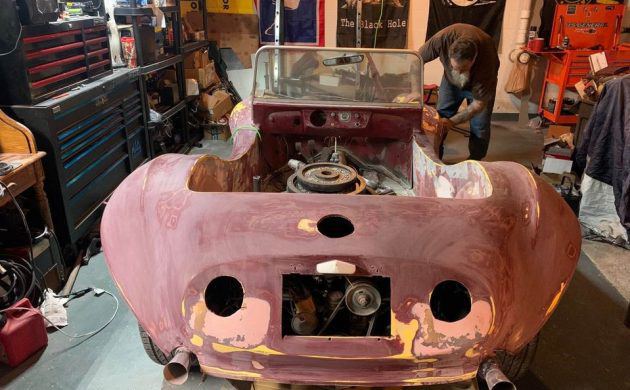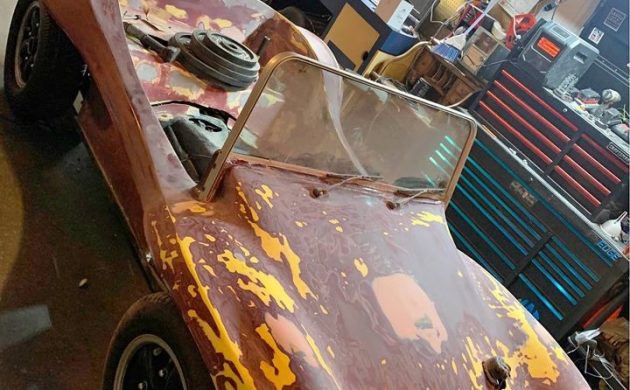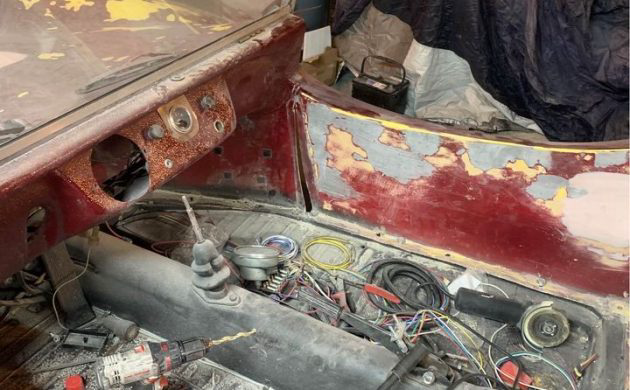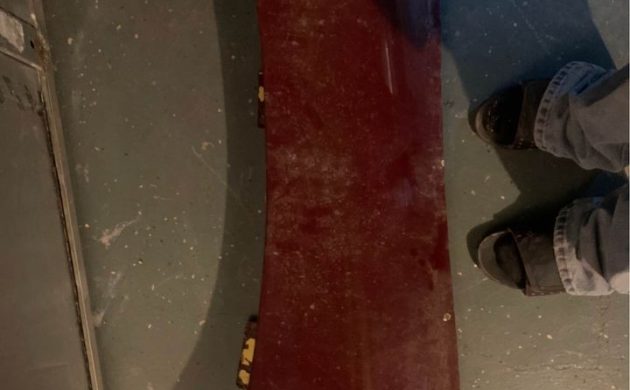The recipe was so brilliantly simple that it bordered on genius. Take a basic VW Beetle platform that could be bought for peanuts in the late 1960s. Then bolt a funky fiberglass body onto it. Apply a paint job that was so bright and loaded with metal-flake that looking at it required sunglasses…and that was in a darkened room! The result was a car that captured the hearts and minds of American youth who didn’t have buckets of money to splash around. If you are old enough that you long to recapture the feel of the 1960s, perhaps this Ocelot Dune Buggy is the project for you. I have to say a big thank you to Barn Finder James B because he’s the man who brought this beauty to our attention. It is located in Red Lion, Pennsylvania, and has been listed for sale here on Facebook. The owner is asking $1,000 OBO for this classic.
It’s probably best to clarify what the buyer will be getting for their money on this one. The asking price is for the body only. The platform beneath isn’t included. That means that you get the funky fiberglass body, the windshield, and the side panels. That might not sound like a lot, but it’s all that you need to transform Humble Herbie into Speed Buggy (and I am aware I’m showing my age with those references!). A couple of companies seem to want to lay claim to the Ocelot, but it appears that it was produced by a company called Sand Chariots in Fullerton, California. Company owner Marion Ruggles had been a builder and distributor of the iconic Meyers Manx but decided to branch out as an independent builder. He drew the inspiration for the Ocelot as a direct competitor to the Manx, right down to the name. The Manx was named after one type of cat, so it seemed fitting that this one should be named after another. The Ocelot gained significant media coverage in the 1960s through a TV show called “Groovy.” This was a Los Angeles beach-based music show hosted by Mike Blodgett. Working on the theory that they had sand, the show’s producers decided that a couple of dune buggies would make great set dressing. The legendary George Barris was called in to apply his custom touches with metal-flake paint and custom interior trim. With the words “The Groovy Ocelot” emblazoned down the side, the little buggy found itself with plenty of media publicity. Unfortunately, this promotion didn’t lead to skyrocketing sales, and Ocelot production ended permanently in 1970. No-one is sure how many were eventually built, but there is an Ocelot Registry that is trying to document as many as possible.
The interior of a dune buggy is very basic, reflecting what these vehicles were all about. There was no point in having expensive upholstery and trim if it would be constantly attacked by sand and saltwater. That is why most of them had vinyl upholstery, and many only had rubber mats on the floor. Gauges and controls were usually anything that could be salvaged from the donor Beetle. This Ocelot doesn’t come with a lot, but the fiberglass appears to be in good condition for its age. There are no significant flaws or problems visible, but it will need a check before it is repainted. One of the more important things is that the windshield and frame are present. The glass might not present a huge hassle to replace, but finding a genuine Ocelot frame could be a battle. Items like exterior lights and their trim shouldn’t pose a problem, because once again, the Beetle is the source for these parts.
The dune buggy was a vehicle very much of its time. They grew out of the swinging ’60s and the surfing culture and were the automotive embodiment of a more relaxed and carefree era. No-one can ever be sure how many buggies were built by various manufacturers, but figures of between 300,000 and 400,000 worldwide seem to be a common estimate. They represent one of the easiest and most straightforward projects that anyone could tackle in a home workshop. However, there is something that has to be considered. Those Beetles that could be bought for pennies in the 1960s have significantly increased in value. That means that building a beach buggy is nowhere near as affordable as it once was. Still, if you do long for a simpler time, maybe this is the project that you’ve been searching for.





This is a project of potential for a big step into the past! A real challenge would be to complete this at the same cost you’d’ve paid in ‘60’s/‘70’s.
This’ll be a hoot to the Ishtar owner, maybe someone with a busted irreparable no-name buggy body or as my Scottish friends say even a “bitsa” job-bits of many Bugs..
A question, though-do fiberglass bodies like these break down to the elements as readily as the plastic we see used on Pontiac Endurance/Saturn-type rigs?
I’ve no idea where “Ishtar owner” came from..it should read “lucky new owner”.
“Ocelot For Not A Lot” Dr. Seuss? LOL
Old dune buggy body only projects where you need to source and build the whole thing are past their prime.
Even though millions of bugs were made. They are in their own right more collectible now than ruining one with a good title and nice pan.
People still drive Bugs. People still wreck bugs. Might take a little looking to find the right donor but that’s part of the fun.
Me thinks it will costalot to get this one up and running.
It appears the body has been cut just behind the seats rather than simply unbolting the body from the frame. I suspect the owner was simply going to trash the body before he heard it might be worth money, hence the Facebook ad.
Not the case. The guy I bought from was trying to make it fit the chassis. Behind the seat there where you are referring to didn’t sit down on the frame like it was suppose to. I’m going to extend that piece to where it sits flush for the perfect mount.
Wait… sandals with socks? Is this a European listing?
Lol no I was being lazy. I had just gotten home from work and didn’t feel like changing.
The access to the engine looks quite limited in the Ocelots rear design.
I built a Manx clone back in the 60’s that had an oval “cobra-like” grill in the front that I purchased it from a magazine ad from the company that sold the kits. The brand-x ad mentioned “dealer inquiries invited”: I convinced them that I would build my “sample” and take orders on the kits! Being a wise ass kid, I was able to order a very complete kit, which included “everything but the doner VW”… Right down to the side curtains and top, for the price of just the Manx body ( which, if I recall correctly, was about $500.00). Gold metal flake paint.I purchased a chassis that was from a 1958 bug that I failed to research fully: the 4 speed was Non- synchromesh in first gear. I should have gotten a newer chassis ( and an engine that didn’t leak copious amounts of oil from the pushrod tubes.) I built it on a shoestring .
The kit itself was not without faults: The body was slightly twisted and never sat right on the chassis. It was fun to build but some of the shortcuts I took building it came back to bite me in the ass. I didn’t re-locate the fuel filler to the top of the front -mounted VW tank; this resulted in gas splashing on the windshield as Drove. Anyone got a match?
The “finale” was when I went to stop one day and felt a squirt of brake fluid on my leg: the brake lines ran inside the cockpit, adjacent to the backbone of the chassis and developed a pin-hole from rust. That day, I (unfortunately) tested the off road capabilities of this vehicle. The very next day, I swapped it with someone for a Mark IX jaguar with a rod nock. This piece of “yard art” sat in my parents side yard for at least 5 years. It was far safer than the dune buggy!
This is so cool!!! Thank you for publishing this!it brightened up my day.
Original Ocelot frame???? VW Beetle floor pan! Most likely shortened 14.5 inches as in most “dune buggies” of the time. Still could be a fun project.